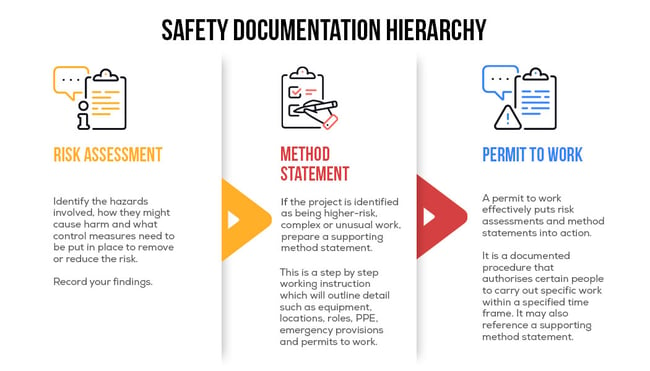The relationship between Risk Assessments, Method Statements and Permits to Work

Risk assessments, method statement and permits to work are all health and safety documents and often found together. They have the same overall purpose of ensuring the work gets done safely and can all cover the same task.
However, despite these similarities, they have distinct roles and are used at different stages in the planning. In this article we will look at the relationship between these three important pieces of Health and Safety documentation.
Is RAMS the same as a method statement?
There can be some confusion around the terminology for risk assessments and method statements. Contractors are often required to provide a RAMS (risk assessment method statement), this simply means that you need to show both your risk assessment and method statements. Don’t however get the two confused, risk assessment and method statements are not the same document. A further complication is that method statements can also be called a safe system of work. Sometimes people will use these terms interchangeably, however the key thing is recognising the role of each document and when to use the right one.
Relationship between Risk Assessment, Method Statement and Permits to Work
The logical sequence of events is to perform a risk assessment and if there is a high level of risk or complexity involved, also prepare a detailed method statement and issue a permit to work.
Your risk assessment should identify the hazards involved and control measures needed to reduce the risk. Method statements are put in place following a risk assessment if the project is identified as being higher-risk, complex or unusual work. The method statement gives further information including a step-by-step safe working guide that employees, contractors, and others can follow.
The permit to work effectively puts risk assessments and method statements into action. It is a documented procedure that authorises certain people to carry out specific work within a specified time frame. For example, a risk assessment identifies the potential hazards involved in a job, a method statement might detail that an electrical circuit needs to be isolated before work can begin. The permit to work will be completed to record when the circuit was isolated, who by, and at what time.
As you can see, although a risk assessment, method statement and permit to work share a common safety goal there are key differences:
- different legal requirements
- different levels of detail
- risk assessments are needed to assess all risks from tasks
- method statements and permits to work are needed for higher-risk or complex activities

What is a Risk Assessment?
Under the Management of Health and Safety at Work Regulations, any business that employs five people or more must conduct risk assessments.
A risk assessment is the process in which hazards are identified in the workplace, working out how much of a risk they pose to employees, contractors, and the general public, and exploring that risk and the potential ways of eliminating or reducing the risk. The level of detail in a risk assessment should be proportionate to the risk and appropriate to the nature of the work.
What is a method statement?
Method statements are not as widely known or used as risk assessments and there is no legal requirement to do them. However, they are common in the construction industry and often required as part of the tender process where the client will ask for RAMS documentation, meaning a risk assessment and method statement. They would also typically be used in infrastructure programs and other complex projects with many moving parts.
Method statement documentation will contain very precise detail about different hazards on site, as well as provide a step by step guide on how to safely perform the task. Everyone involved in the task should get a copy of the method statement which can be thought of as instructions on how to carry out the work. The sorts of detail it should contain includes:
- Equipment, machinery and plant involved
- Individual responsibilities
- Locations
- PPE requirements
- Monitoring arrangements
- Site specific rules and restrictions
- Details of first aid and emergency procedures
- Sequence of work and timeframe
- Any specific training requirements
- Any supporting permits to work required
What is Permit to Work?
The permit to work effectively puts risk assessments and method statements into action. It is a documented procedure that authorises certain people to carry out specific work within a specific time frame. The permit to work sets out the measures required to complete the work safely, based on a risk assessment. It describes what work will be done and how it will be done and may reference a supporting method statement.
The permit to work requires signatures from the people authorising the work and carrying out the work. Where necessary it requires a declaration from those involved in shift handover procedures or extensions to the work. Finally, before equipment or machinery is put back into service, it will require a declaration from the permit originator that the area is ready for normal use.
Summary
Obviously, there is plenty of overlap between a risk assessment, method statement and a permit to work but the thing that sets them apart is the different levels of detail needed to complete the job safely. A risk assessment is a mandatory appraisal of the job and its inherent risks. A method statement or safe method of working breaks this down into a detailed set of work instructions. A permit to work puts that plan into action at an operational level.
If you are managing a project which involves all three, you need to keep a lot of balls in the air. This is where you can immediately see the benefit of using contractor management and EPermit software. A digital platform is the perfect way to bring all of your supporting information into one place where it can be easily shared and engaged with. Step-based workflows and checklists can guide users through the different procedures and prompt if any key information is missing.
It's all too easy for important safety documentation to end up gathering dust on a shelf, contractor management software makes everything accessible, dynamic and accountable.
About Lisa Robinson
Lisa - word smith to the gods.

